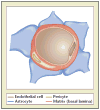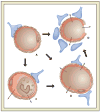Virchow's triad: the vascular basis of cerebral injury
- PMID: 18645567
- PMCID: PMC2693906
Virchow's triad: the vascular basis of cerebral injury
Abstract
Both the large arteries and microvascular beds of the central nervous system respond to injury by initiating processes compatible with Virchow's triad: alterations in the microvascular permeability barrier, reduction in flow with the target bed, and/or thrombosis of brain-supplying arteries and of the microvasculature. This is particularly true during focal cerebral ischemia. The temporal and topographical coincidence of neuron injury and microvessel response during focal ischemia has suggested that neuron-microvessel interactions could be bidirectional. The neurovascular unit offers a conceptual and structural framework with which to examine events within the microvasculature and their impact on neuron integrity, with the participation of the intervening astrocytes, matrix, and other supportive cells (eg, pericytes and oligodendroglia). Activation of the endothelium and of coagulation, capture of leukocytes, and increased microvessel permeability lead to the focal "no-reflow" phenomenon. Decreased shear stress is a component of the evolving ischemia. Strategies that inhibit the interactions within the microvasculature have been shown to prevent no-reflow and improve neurological outcome. It is, therefore, possible that addressing the processes of Virchow's triad in the setting of focal ischemia could promote neurovascular function.
Conflict of interest statement
The author has no real or apparent conflicts of interest to report.
Figures



References
-
- Grant DS, Kleinman HK. Regulation of capillary formation by laminin and other components of the extracellular matrix. EXS. 1997;79:317–333. - PubMed
-
- David S, Braun PE, Jackson DL, et al. Laminin overrides the inhibitory effects of peripheral nervous system and central nervous system myelin-derived inhibitors of neurite growth. J Neurosci Res. 1995;42:594–602. - PubMed
Publication types
MeSH terms
Grants and funding
LinkOut - more resources
Full Text Sources
Medical
